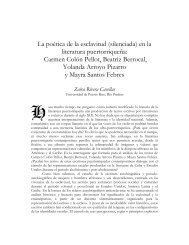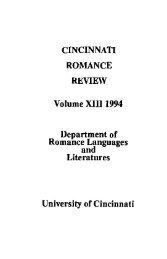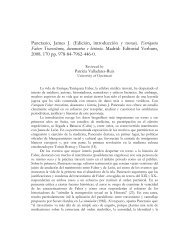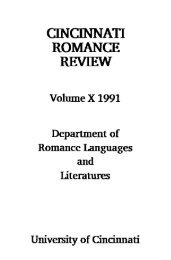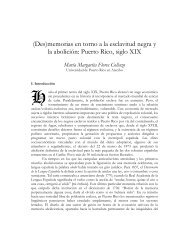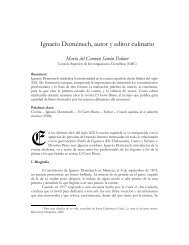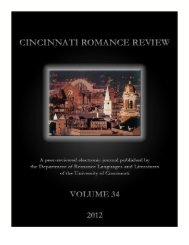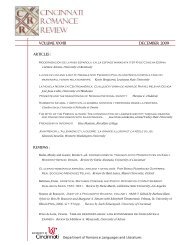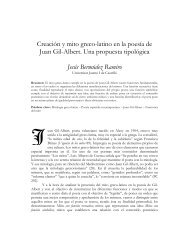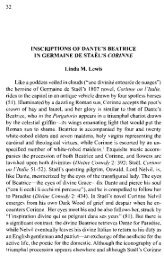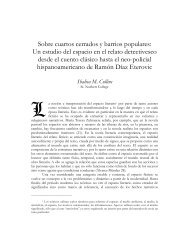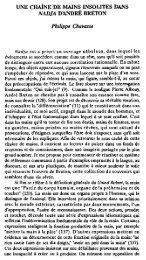Volume 30 (2011) - Cincinnati Romance Review
Volume 30 (2011) - Cincinnati Romance Review
Volume 30 (2011) - Cincinnati Romance Review
Create successful ePaper yourself
Turn your PDF publications into a flip-book with our unique Google optimized e-Paper software.
(A)CERCAMIENTO AL CONCEPTO DE LA NEGRITUD 45<br />
Hay un llanto de gaitas<br />
Diluído en la noche<br />
………………………………<br />
¡Cumbia! – danza negra, danza de mi tierra!<br />
Toda una raza grita<br />
………………………………<br />
Late un recuerdo aborigen<br />
Una africana aspereza. (101)<br />
Hablando precisamente de la cumbia, Delia Zapata Olivella revela su carácter<br />
sincrético. Dice lo siguiente la escritora afro-colombiana:<br />
The continuous contact between Indians and Blacks during Colonial<br />
servitude and their intercourse under the impose circumstances by their<br />
common submission to the slave owners, must have produced, among<br />
its consequences, the approaching and the partial fusion of their musical<br />
expressions: the melancholy gaita or indigenous flute, in close contrast<br />
with the happy and impetuous resonance of the African drum. Thus<br />
emerge this rhythm that we call cumbia and which today incarnates the<br />
feeling of a large portion of the Colombian people. (190-91)<br />
Además del baile y la música, uno de los rasgos representativos de la identidad<br />
afro-colombiana es el lenguaje; una mezcla del español con rasgos fonéticos africanos<br />
[lo que John Lipski llama “bozal spanish” en A History of Afro-Hispanic Language (2005)].<br />
Esta creolización del español se hace más patente en las obras de Candelario Obeso,<br />
Helcías Martán Góngora y Salazar Valdés donde los rasgos fonéticos se caracterizan por<br />
la elipsis de sílabas y fonemas [“RA” y “S”] en algunas palabras (pa = para) (má = más);<br />
la prótesis de fonemas y sílabas (creigas = creas); la asimilación de fonemas (/i/ = /r/;<br />
/r/ = /d/; /r/ = /l/; /j/ = /s/); la elipsis o la aspiración de la consonante /d/ antes de<br />
la vocal /e/ (espué = después) ( e = de); el fonema /j/ en posición inicial se convierte<br />
en /f/(jiejta = fiesta); el /l/ en /b/ ( lujca = busca) y La vocal tónica /á/ substituye a la<br />
terminación infinitivo “-ar” (va a regalá = va a regalar). Una muestra del habla afrocolombiano<br />
se destaca en los versos siguientes de Cantos populares de mi tierra:<br />
Trite vira é la der probe,<br />
cuando er rico goza en pá,<br />
er probe en er monte sura<br />
O en la má<br />
Er rico poco efuecza<br />
y nunca le farta ná<br />
toro lo tiene onde moro<br />
<strong>Cincinnati</strong> <strong>Romance</strong> <strong>Review</strong> <strong>30</strong> (Winter <strong>2011</strong>): 39-52.



